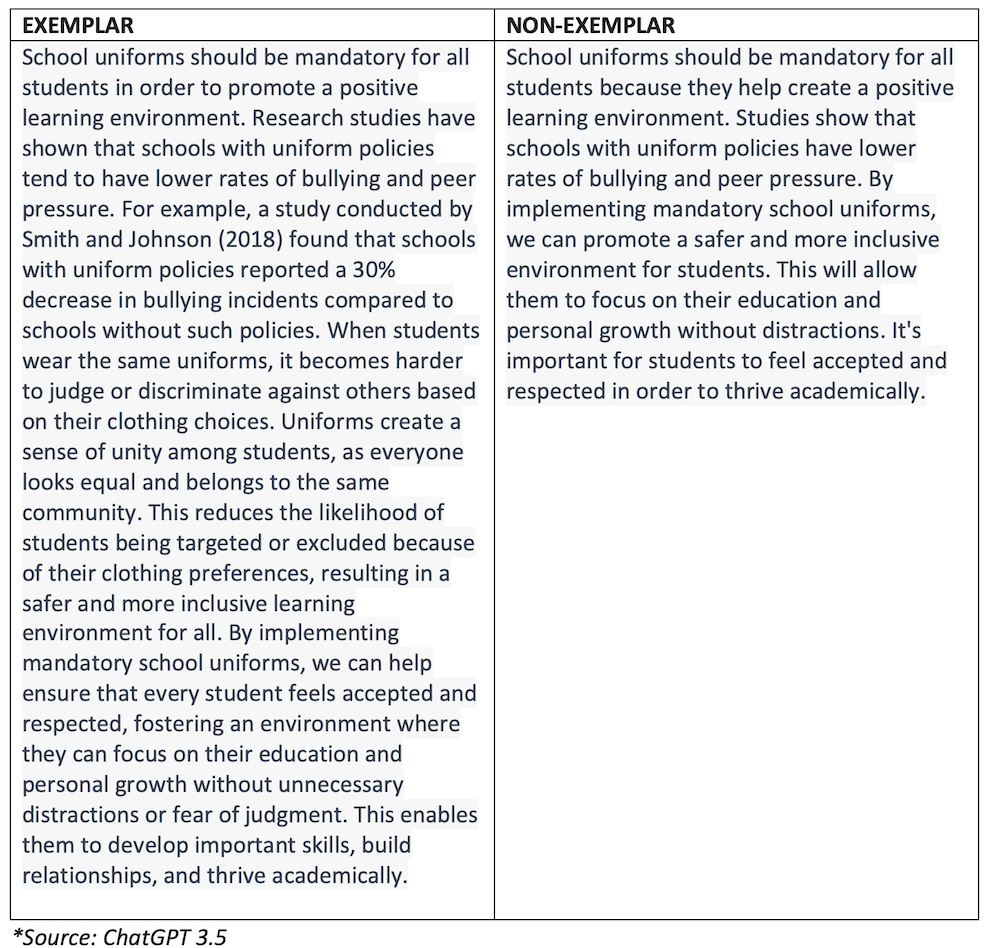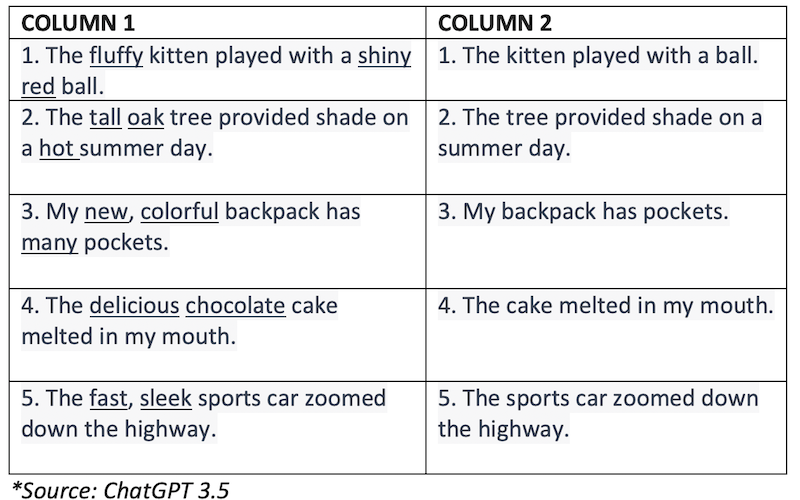Writing: Let ChatGPT Create Your Exemplars
By Sarah Tantillo
 As we look ahead to a new school year with artificial intelligence tools widely available, many teachers are wondering not just “How can I prevent my students from using AI to cheat?” but “How can I use AI tools to enhance my instruction?”
As we look ahead to a new school year with artificial intelligence tools widely available, many teachers are wondering not just “How can I prevent my students from using AI to cheat?” but “How can I use AI tools to enhance my instruction?”
I have some good news: AI chatbots such as ChatGPT and Bard can DRAMATICALLY strengthen writing instruction.
“What? Are you serious?”
Yes. Let me explain.
Let’s first acknowledge that it is difficult to teach someone how to write. Ideally, you would share exemplars and non-exemplars of the writing task and have students analyze the differences between them in order to infer what makes the exemplars effective.
But who has time to create all of those models? Instead, teachers often ASSIGN writing (“Write a five-paragraph essay on ___!”), offer brief organizational guidance on what to include (“An intro with a thesis!” and “Three body paragraphs!” and “Don’t forget your conclusion!”), and then sit back and brace themselves.
The result is predictable: many students struggle, and the teacher doesn’t have time to meet with them all individually. Students become frustrated and announce that they “hate writing.” The teacher, equally frustrated and stressed, isn’t sure what to do.
Some teachers go the other way and OVER-scaffold. They give students fill-in-the-blank introduction paragraphs (“to help get you started”), then write the first body paragraph “together,” and then are surprised when students are reluctant to even begin the next body paragraph on their own.
“This sounds terrible. I thought you were going to explain how to use AI to help me?”
Yes. Let’s go back to that ideal scenario, in which we provide exemplars and non-exemplars. Chatbots like ChatGPT and Bard can create as many pairs of text as we desire, customized to your heart’s content—by grade level, genre, topic, writing skill (or lack thereof), grammatical issue, and so on.
“Cool! What would AI supported writing instruction look like, then?”
Here’s a suggested lesson sequence:
►1. MINI-LESSON: Analyze the genre by reading a few AI-generated exemplars. Discuss the purposes of this genre (e.g., inform, persuade, inspire, entertain). Ask students: “What do we know about this genre? What do we think are some key elements of this genre?”
►2. MINI-LESSON: Compare AI-generated exemplars vs. non-exemplars. Ask: “Now what do we think are key elements of this genre? What makes the exemplars good?”
Here’s an example for argumentative paragraph writing generated by AI. The wording of your prompt is important – you’ll get the hang of it with practice. Here’s the AI prompt I used:
“You’re an expert in writing effective paragraphs. Write an exemplar and a non-exemplar argumentative paragraph at the 6th grade level. Include a claim/argument, evidence, explanation, and punchy insight in the exemplar. Leave explanation out of the non-exemplar.”
Asking “What do you notice?” as students read these texts would lead to a discussion about key components of effective argumentative paragraphs. The exemplar has an argument/claim, evidence, explanation, and a punchy, insightful conclusion. The non-exemplar lacks explanation. Students can quickly see and discuss the value of EXPLAINING in their writing.
►3. Students write their own drafts, attempting to include the key elements they noticed in the exemplars.
►4. Students pair up and engage in the PARTNER FEEDBACK PROTOCOL. The writer reads aloud while sitting side-by-side with their partner, who does only these three things: 1) Praise specific things they like about the writing, 2) Ask clarifying questions, and 3) Ask the writer to elaborate. The writer does not answer the questions directly but instead makes notes to answer these questions later (in their revision), then keeps on reading aloud.
►5. COLLECT WORK AND REVIEW TRENDS TO PREPARE THE NEXT MINI-LESSON. Use AI to generate customized exemplars and non-exemplars to support needed revision work. For example, if students are not including relevant evidence, provide paragraphs that include relevant evidence to be compared with those offer random/irrelevant “evidence.”
►6. MINI-LESSON: Compare these customized exemplars vs. non-exemplars. Students look at their own writing to see how it mirrors the exemplars or non-exemplars. Ask: “What do you see in the exemplars that you want to do more effectively in your own writing?”
►7. Students revise their drafts.
►8. While some students engage in the PARTNER FEEDBACK PROTOCOL, conduct WRITING CONFERENCES with small groups of students. (For more info on the Partner Feedback Protocol and Writing Conferences, see this TLC Blog post.)
►9. BASED ON OBSERVATIONS OF STUDENT WORK SO FAR, select grammar points to teach. Use AI to generate T charts like the one below with exemplary/non-exemplary sentences to help students zero in on key points.
►10. MINI-LESSON: Compare those exemplars vs. non-exemplars to bring the grammar points home. In the case below, you might say this: “The sentences in Column 1 include adjectives, which are underlined; the sentences in Column 2 do not. “What does an adjective do? Why do you think good writers use adjectives?” Then ask: “What do you notice in YOUR writing that needs to be addressed?”
AI Prompt: “You are an expert on grammar and writing. Create a 2-column chart in which 5 sentences in Column 1 use adjectives that are underlined and 5 sentences in Column 2 use the same sentences without the adjectives. Write these at 4th grade level.”
►11. Students revise/edit and submit final drafts.
►12. PROVIDE FEEDBACK FOR FUTURE WRITING. Assuming students have not fully mastered the genre, what should they keep in mind for next time? Note: You can use AI to create the rubric and to provide feedback with suggested next steps; just be sure to evaluate the AI outputs to ensure they accomplish your aims.
►13. Create another assignment in which students write a new piece in the same genre. AI can help you generate topics/prompts for this new assignment.
►14. REPEAT THE CYCLE.
The learning possibilities are endless! And the time saved? Priceless.
See Sarah’s AI Tips
(with answers to common teacher questions)
at her website.
Sarah Tantillo is a national literacy and student achievement consultant based in New Jersey. Her latest book for teachers, Using Grammar to Improve Writing: Recipes for Action is available on Amazon, Barnes & Noble, and BookShop. Her other books include The Literacy Cookbook (Jossey-Bass, 2012), Literacy and the Common Core: Recipes for Action (Jossey-Bass, 2014). Check out her website The Literacy Cookbook and her TLC Blog. See her many MiddleWeb articles here.































